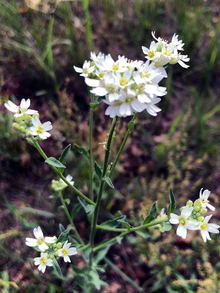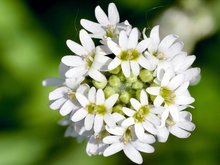Quick facts
Hoary alyssum is an invasive species.
- Hoary alyssum displaces native species in dry prairies and sand blowouts where vegetation is sparse.
- It is also found in disturbed dry fields, fields and waste lands.
Hoary alyssum should be reported. The Minnesota Department of Natural Resources provides detailed recommendations for reporting invasive species.
How to identify hoary alyssum
- Hoary alyssum (Berteroa incana) is an annual, biennial or perennial herbaceous plant one to three feet tall; member of the mustard family.
Stem
- Erect, branched, gray-green downy stem with many branches near the top.
Leaves
- Alternate, small (one half to three inches), lance-shaped leaves covered with a grayish-green hairy down; smooth leaf edges.
Flowers
- Tiny white flowers are arranged in elongated clusters along a central stem.
- Each flower has four deeply divided petals that produce a long raceme.
- Blooms June through August.
Seeds
- Seed pods are round to oblong, narrowly winged, hairy and swollen, with beaks at the end.
- Seeds are rough, dull gray-brown and oblong.
- Spreads and reproduces by seeds.
Roots
- Taproot
Hoary alyssum
Reviewed in 2019



